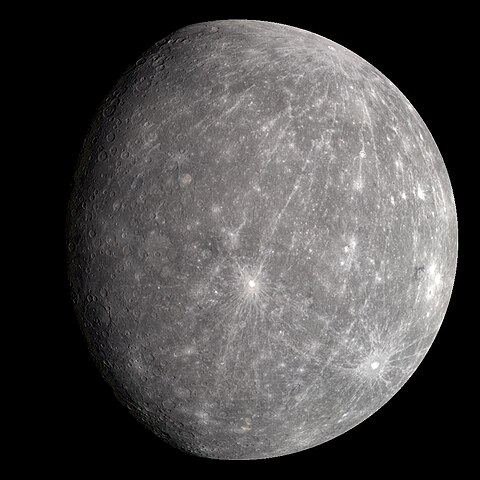
What happened to the water on other planets? It was either blown off, evaporated off, or is still there but frozen in ice.
The first thing we have to consider is that not all of the planets have water. Pluto has obviously been deregulated and is no longer a planet. Earth has water. Saturn and Jupiter are gas giants that don’t have any water. That leaves Mercury, Venus, Mars, Uranus, and Neptune. Let’s look at the gas giants first.
Uranus is the 7th planet from the sun and Neptune is the 8th. These planets are gas giants, but recently they have been renamed “ice giants” because they contain a lot of water and ice. Both Neptune and Uranus have a rocky core that is under immense pressure from all of the gas they are made of. It was long thought that they were gas giants, the same as Saturn and Jupiter, but it turns out that these planets have methane, ammonia, and water in their atmospheres. There may also be a lot of water at their core, but this water would be so hot because of the pressure that it would be a superfluid. Jupiter and Saturn also have some water vapor in their atmospheres, but this is less than half of one percent of their atmospheres, so it is negligible.
Mercury has lost nearly all of its water because it is so close to the sun and it is bombarded by the solar winds. It is only 47 million km away from the sun at its closest, compared to Earth’s 150 million km. Mercury probably had an atmosphere soon after it was formed, but that atmosphere wouldn’t have hung around for very long. Mercury is too small to have enough gravity to keep an atmosphere and any atmosphere it had got ripped away by the solar wind, which is a stream of particles coming off the sun. We are protected by our magnetic field and atmosphere. Notwithstanding the incredible heat from being so close to the sun, Mercury does actually have water. There is a lot of frozen water deep inside impact craters that is protected from the sun’s heat. There is also ice at the polar caps of the planet. This ice is covered by a 30 cm deep black layer that appears to reflect the heat back and keep the ice cool. This layer may be organic and it could have come from the impacts of comets. There is a possibility that it is the same material that brought water and life to Earth.
The planet Venus doesn’t have any water at all on its surface. It does have an atmosphere and 0.002% of this is water. That is a very small amount. Venus is about the same size as Earth and experts think that it may have started with the same amount of water that we have. However, Venus lost most of its water because of the greenhouse effect. It has a very thick atmosphere that holds in heat and the surface temperature of Venus is way above the boiling point of water. All of the water on Venus evaporated into the atmosphere. So, is there still water in the atmosphere? Most of the water has been stripped out of the atmosphere by the UV radiation from the sun and has escaped into space. The UV radiation can break the bonds between the oxygen and the hydrogen atoms and the hydrogen atoms are blasted into space.
Mars has polar ice caps, underground water, and some water in its atmosphere, but most of the water that used to be there has gone. The proof that there used to be liquid water on Mars is evident all over its surface. There are the marks left by rivers, deltas, and seas. Now, though, there is mostly just rusty dust on the surface. Where did the water go? On Venus and Mercury, there is no water because of the heat. On Mars there is no water because of the cold. Mars used to have an atmosphere that kept the planet warm enough for water to flow as a liquid. Shortly after it was formed, in the same way as Mercury, the atmosphere was stripped off by the solar winds and Mars’ lack of gravity. Once the atmosphere had gone, the remaining water either evaporated into space, or froze. When we colonize Mars, we could use this water for our habitats. Possibly, And this is what I learned today.
Image By NASA/Johns Hopkins University Applied Physics Laboratory/Arizona State University/Carnegie Institution of Washington – https://photojournal.jpl.nasa.gov/catalog/PIA11364, Public Domain, https://commons.wikimedia.org/w/index.php?curid=83618472
Sources
https://www.space.com/diamond-rain-atmosphere-uranus-neptune
https://science.nasa.gov/mercury/facts
https://nssdc.gsfc.nasa.gov/planetary/ice/ice_mercury.html
https://www.theguardian.com/science/2015/apr/16/nasa-spacecraft-mercury-messenger-water-crash
https://en.wikipedia.org/wiki/Neptune
https://en.wikipedia.org/wiki/Uranus
https://www.bu.edu/csp/PASS/science/venusfaq.html
https://www.esa.int/Science_Exploration/Space_Science/Venus_Express/Where_did_Venus_s_water_go
https://www.usgs.gov/news/tour-water-solar-system
https://now.northropgrumman.com/where-did-the-liquid-water-on-mars-go-is-it-still-there
https://en.wikipedia.org/wiki/Water_on_Mars
